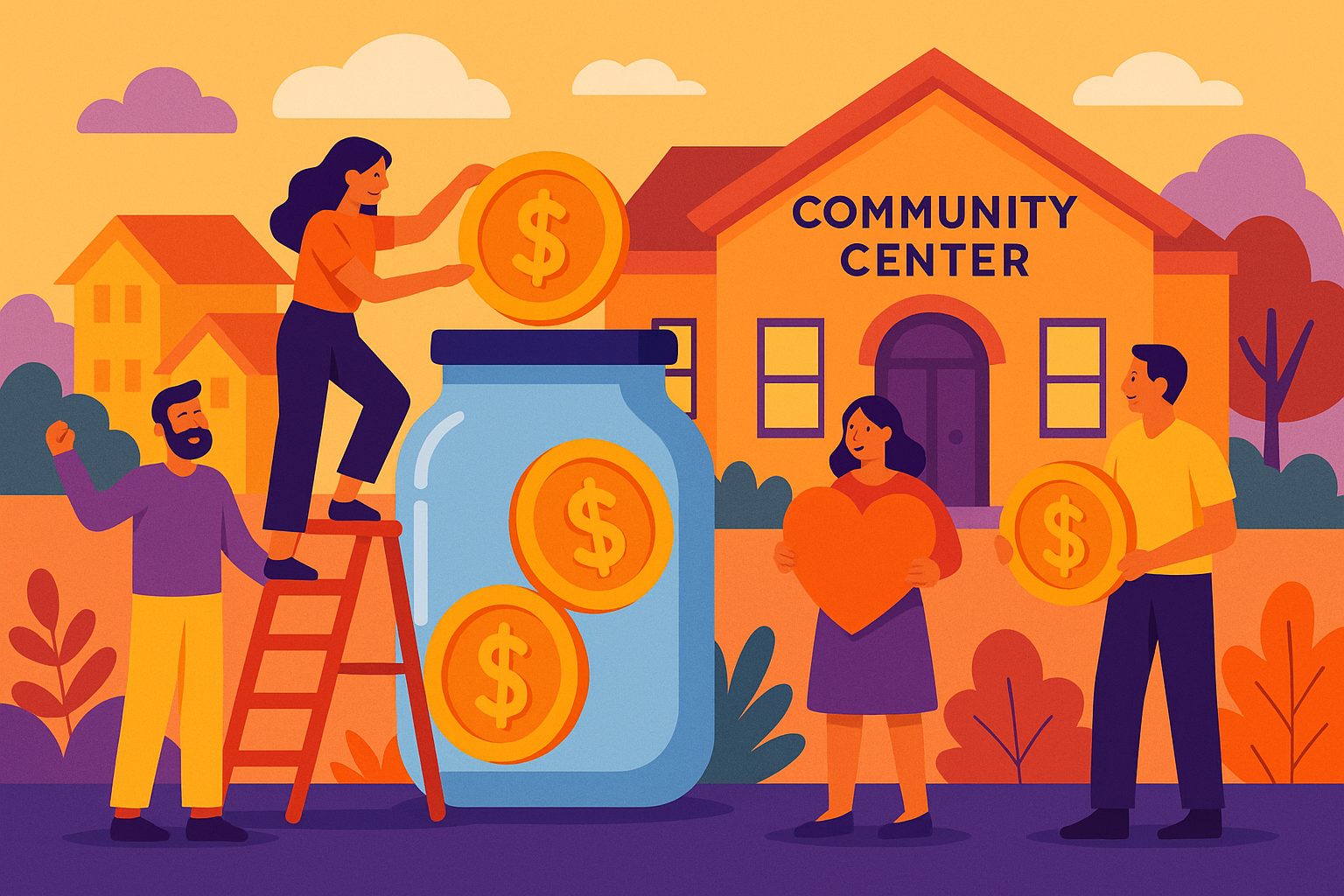Rethinking City Life Through Collective Action
Cities have long been defined by their steel skylines and endless concrete, but a new kind of grassroots power is reshaping the urban landscape—one park bench, community garden, and green rooftop at a time. Civic crowdfunding, an innovative blend of public participation and digital fundraising, is breathing life into neglected urban green spaces. Across the globe, communities are taking ownership of their environments in a movement that blends technology, social purpose, and ecological resilience.
What once required top-down government initiatives and lengthy bureaucratic channels is now increasingly fueled by the will of everyday people. From restoring pocket parks in Detroit to transforming railway corridors into lush walkways in London, civic crowdfunding is not just a funding model—it’s a revolution in public engagement and city regeneration.
The Power Behind the Platform: How Civic Crowdfunding Works
Civic crowdfunding enables individuals to contribute financially to local projects that improve public spaces, often through platforms like Spacehive, ioby, GoFundMe, or Kickstarter. These projects are generally proposed by citizens, nonprofit groups, or even local governments and range from planting trees to revitalizing vacant lots into green havens. The beauty of the model lies in its decentralization—everyone can pitch in, from neighbors donating a few dollars to city councils offering matching grants.
Once a project idea is launched on a platform, it typically undergoes a public campaign phase where community members are encouraged to pledge support. The transparency of these platforms ensures that every dollar is accounted for and every supporter becomes a stakeholder in shaping the future of their neighborhood. In many cases, successfully crowdfunded projects also attract in-kind donations, volunteer labor, and institutional backing, creating a multiplier effect that amplifies the impact.
From Blight to Bloom: Real Stories of Transformation
The most compelling witness to civic crowdfunding’s effectiveness comes from the stories of neighborhoods that have been transformed. In the Bronx, a derelict alleyway once used for illegal dumping was transformed into the “Melrose Commons Garden” thanks to a crowdfunding campaign supported by local families, artists, and a community development corporation. It is now a community hub full of native plants, seating areas, and educational programming.
Meanwhile, in Sheffield, England, a campaign on Spacehive led to the creation of “Grey to Green,” a striking stretch of rain gardens and pedestrian walkways in an otherwise traffic-heavy corridor. This urban greening project was a mix of community funds, local business support, and municipal matching grants, demonstrating the synergy that civic crowdfunding often inspires.
These stories are not isolated. Across Los Angeles, Nairobi, Melbourne, and São Paulo, small but mighty campaigns are proving that when people are given the tools and agency to improve their environments, the results are profound and lasting.
Why Green Spaces Matter More Than Ever
Urban green spaces are far more than aesthetic add-ons—they are essential to the health and vitality of modern cities. These spaces reduce the urban heat island effect, improve air quality, manage stormwater, and offer refuge from the pressures of fast-paced city life. They also promote biodiversity, offering critical habitat for pollinators, birds, and small mammals in even the most developed environments.
But green spaces also play a powerful social and psychological role. Access to greenery has been consistently linked with improved mental health, reduced stress, and stronger community cohesion. In cities where concrete dominates and housing density continues to climb, public green areas offer an invaluable form of social infrastructure.
Unfortunately, many cities suffer from green inequity—where wealthier neighborhoods enjoy tree-lined streets and abundant parks, while marginalized communities face a shortage of safe and accessible green areas. Civic crowdfunding has emerged as a powerful equalizer, giving underserved communities the opportunity to advocate for and create the green spaces they desperately need.
The Digital Commons Meets Urban Ecology
What makes civic crowdfunding especially effective for urban greening is its ability to blend the best of digital innovation with real-world environmental action. Platforms serve as a kind of digital commons—a place where ideas are shared, campaigns are launched, and transparency is paramount. These platforms also make data visible to potential backers, showing impact metrics, fundraising milestones, and even geolocation maps of upcoming projects.
Moreover, social media plays a crucial role in the success of campaigns. Sharing a local park revitalization project on Instagram or TikTok can galvanize support far beyond one’s immediate neighborhood. Local influencers, city councilors, and even celebrities often jump on board to boost visibility. In this sense, civic crowdfunding becomes a participatory ecosystem, where digital momentum drives tangible, physical change.
Through storytelling, visuals, and direct outreach, projects are able to connect emotionally with their audiences. Whether it’s a mom advocating for a community play area or a teen raising awareness about climate change, civic crowdfunding gives voice to people who have long been left out of traditional urban planning discussions.
Government’s New Role in Citizen-Led Projects
While civic crowdfunding starts with the people, local governments are increasingly becoming essential allies in this grassroots movement. In cities like New York, London, and Amsterdam, municipal agencies are actively partnering with crowdfunding platforms to co-fund approved community projects. These public-private collaborations not only legitimize crowdfunding efforts but also extend their reach and sustainability.
In some instances, governments create “civic match funds” that promise to double every dollar raised by the public, effectively supercharging campaigns. Others offer technical guidance, fast-track permitting, or inclusion in long-term urban planning frameworks. This shift marks a broader recognition that civic engagement is not just a feel-good initiative—it’s a legitimate method of place-making and public value creation.
Civic crowdfunding is also helping municipalities gauge which projects hold the most public interest. By observing which campaigns gain traction, city officials get a unique window into the collective priorities of their constituents. This real-time feedback loop has the potential to reshape how urban policy is created, moving away from top-down models toward more dynamic, inclusive approaches.
Overcoming Challenges in the Civic Funding Model
Despite its promise, civic crowdfunding is not without challenges. One concern is the potential for inequality in which communities can organize, promote, and fundraise effectively. Wealthier areas may have more time, digital literacy, and donor networks, while under-resourced communities may struggle to get their projects off the ground. Platform fees, lack of marketing skills, or simply the exhaustion that comes with grassroots organizing can become real obstacles.
To address this, many platforms now offer coaching, grant-writing support, and storytelling templates to help level the playing field. Equally important is the role of intermediaries—nonprofits, schools, libraries, and even small businesses—that help amplify the efforts of community leaders and make campaigns more viable.
There’s also the challenge of maintaining momentum post-campaign. A revitalized park needs upkeep, a community garden requires volunteers, and a green roof project might need continued technical support. That’s why sustainability plans and community buy-in are often built directly into project proposals, ensuring that civic crowdfunding projects remain resilient well after the donations have been counted.
Environmental Justice Meets Financial Innovation
At its heart, civic crowdfunding is a form of environmental justice. It’s a way for historically overlooked neighborhoods to not only advocate for better public spaces but to directly participate in creating them. It gives residents the financial tools and visibility needed to break through bureaucratic red tape and push their visions into reality.
What’s more, it introduces a new kind of financial innovation—hyperlocal investment. Supporters are not looking for a financial return, but a social one: safer parks, greener blocks, cleaner air, and healthier kids. These are dividends that don’t show up in a stock portfolio but are felt in the day-to-day fabric of urban life.
For investors, philanthropists, and foundations, civic crowdfunding presents a model that combines measurable impact with high visibility and strong community engagement. Many are starting to view their contributions as social capital investments, helping to strengthen the connective tissue of urban neighborhoods.
A Global Movement in Full Bloom
From the “Parklets” of San Francisco to Nairobi’s “Mtaa Spaces” and Tokyo’s “Machizukuri” projects, civic crowdfunding has become a truly global phenomenon. While the methods may vary, the essence remains the same—ordinary people shaping extraordinary change in their communities.
Technology continues to bridge cultural, linguistic, and geographic divides, making it easier than ever to collaborate across cities and borders. Open-source urbanism, participatory mapping, and even blockchain-based transparency tools are adding new dimensions to how civic projects are proposed, monitored, and replicated.
This movement is also intersecting with climate action in powerful ways. As cities look for scalable, community-driven responses to environmental threats, civic crowdfunding is offering proven, people-powered solutions. From climate-resilient landscaping to pollution-buffering tree canopies, green space projects are increasingly aligned with larger climate mitigation goals.
What the Future Holds for Urban Crowdfunding
The future of civic crowdfunding is one of deeper integration, both technologically and politically. With smart city infrastructure on the rise, we may soon see real-time data on green space usage feeding directly into crowdfunding campaigns. Imagine your local park’s foot traffic data triggering automatic alerts when renovation campaigns are needed—or augmented reality helping people visualize what a transformed space could look like before they donate.
Civic platforms are also evolving to support recurring donations, micro-subscriptions, and even decentralized decision-making tools that let backers vote on project elements. The very structure of how we co-fund and co-create cities is being reinvented, blurring the line between citizen and policymaker.
If cities are the collective reflection of their people, then civic crowdfunding is a mirror of modern urban values: participation, sustainability, creativity, and care. As more communities realize the latent power in their collective voices and wallets, urban spaces will continue to flourish—not because of a single vision from above, but because of countless visions from within.
Reimagining the Green Heart of the City
In the end, civic crowdfunding is not just about funding—it’s about belonging. It’s about reclaiming agency in a world where too many feel alienated from the decisions that shape their everyday lives. It’s about seeing a vacant lot not as a symbol of decline, but as a canvas for hope.
Urban green spaces are more than amenities—they are declarations of what we value as a society. And through civic crowdfunding, cities are learning that the most powerful urban planning tools are not housed in bureaucracies or banks—but in the collective energy, imagination, and resolve of their people.
As we walk down tree-lined blocks that once lay forgotten, we are reminded that change is always possible, and that sometimes, the most revolutionary thing you can do is help plant a seed.




